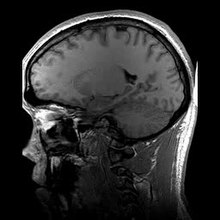Magnetic resonance Imaging
| Magnetic resonance imaging | |
|---|---|
| Medical diagnostics | |
|
Para-sagittal MRI of the head, with aliasing artifacts (nose and forehead appear at the back of the head)
|
|
| Synonyms | nuclear magnetic resonance imaging (NMRI), magnetic resonance tomography (MRT) |
| ICD-9-CM | 88.91 |
| MeSH | D008279 |
| MedlinePlus | 003335 |
Magnetic resonance imaging (MRI) is a medical imaging technique used in radiology to form pictures of the anatomy and the physiological processes of the body in both health and disease. MRI scanners use strong magnetic fields, radio waves, and field gradients to generate images of the inside of the body.
MRI is distinct from computed tomography (CT), or (CAT). Whereas CT uses higher-energy x-rays with known harmful effects, MRI operates in the radio-frequency portion of the spectrum where there is much less evidence of harm. While the hazards of x-rays are now well understood and mitigated in most medical contexts, MRI can still be seen as superior in this regard. MRI can often yield different diagnostic information compared with CT. MRI scans have the disadvantages of being longer in duration, louder, and usually require that the subject be placed in a narrow and relatively long tube. In addition, people with some medical implants or other non-removable metal inside the body may be unable to safely undergo an MRI examination.
MRI is based upon the science of nuclear magnetic resonance (NMR). Certain atomic nuclei can absorb and emit radio frequency energy when placed in an external magnetic field. In clinical and research MRI, hydrogen atoms are most-often used to generate a detectable radio-frequency signal that is received by antennas in close proximity to the anatomy being examined. Hydrogen atoms exist naturally in people and other biological organisms in abundance, particularly in water and fat. For this reason, most MRI scans essentially map the location of water and fat in the body. Pulses of radio waves excite the nuclear spin energy transition, and magnetic field gradients localize the signal in space. By varying the parameters of the pulse sequence, different contrasts can be generated between tissues based on the relaxation properties of the hydrogen atoms therein. Since its early development in the 1970s and 1980s, MRI has proven to be a highly versatile imaging technique. While MRI is most prominently used in diagnostic medicine and biomedical research, it can also be used to form images of non-living objects. MRI scans are capable of producing a variety of chemical and physical data, in addition to detailed spatial images.
...
Wikipedia

